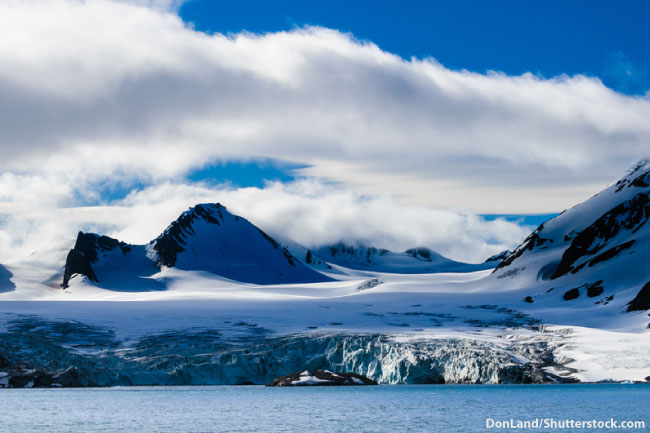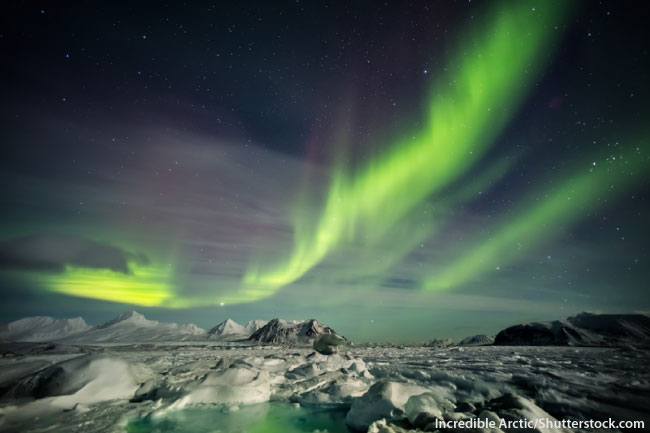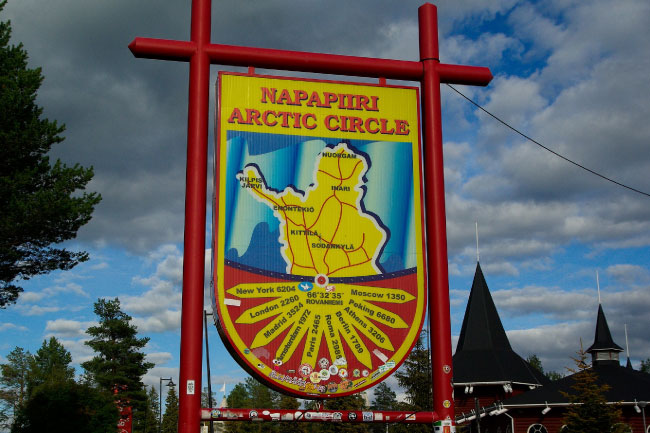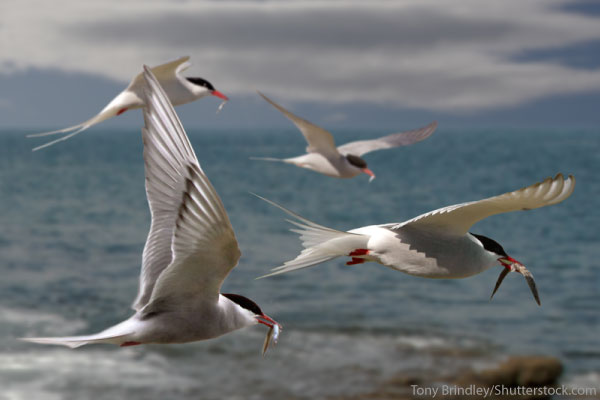The Arctic facts for kids: read on to find incredible facts and figures about this amazing polar region.
In this article, you'll find out where the Arctic is, learn about its climate and wildlife, and discover what life is like at the northernmost part of the world ...
The Arctic Facts For Kids: What Is The Arctic?
The Arctic is the region around the North Pole. It is a sea of ice, surrounded by cold, treeless lands.
Despite these inhospitable conditions, the Arctic is home to many animals and plants. Many species living here have evolved special adaptations to live in the harsh environment.
The Arctic is the ‘Land of the Midnight Sun’. In the summer, months go by without the sun setting. In the winter, ‘Polar Nights’ – during which the sun never rises – also last for several months.
The North Pole itself is the northernmost point of Earth. Unlike the South Pole, which is on land, the North Pole is situated in the frozen sea ice of the Arctic Ocean.
Amazing Arctic Facts For Kids (and Adults!)
(In a hurry? You'll find a quick list of interesting Arctic facts at the bottom of the page.)
Where Is The Arctic?
There are actually several definitions of where –and what – the Arctic is.
The most commonly used definition of the Arctic is the ‘region north of the Arctic Circle’. (You can find out what the Arctic Circle is below.)
Another definition of the Arctic is the ‘region in which the average temperature of the warmest month is under 10°C (50°F)’. Other definitions have been created by governments and organizations to include various geographical features and boundaries.
How Big Is The Arctic?
Using the ‘north of the Arctic Circle’ definition, the Arctic has an area of around 20 million km² (7.7 million square miles).
The Arctic Circle
What is the Arctic Circle?
The Arctic Circle is an imaginary line that circles the northernmost parts of the earth. This circle runs parallel to the Equator.
This Arctic Circle's position isn’t fixed. Instead, it marks the region in which, for at least 24 hours in a year, the sun doesn’t fall below the horizon (and also, for at least 24 hours in winter, the sun doesn’t rise above the horizon).
In fact, due to variances in the earth’s axial tilt*, the Arctic Circle is currently migrating slowly northwards about 15 m (49 ft.) every year.
* As the earth revolves around the sun (to give us years), it is itself spinning (to give us days and nights). The earth is tilted to one side as it spins, and this is known as the ‘axial tilt’. The angle at which the earth is tilted changes fractionally over time due to the moon and the tides.
The Arctic Circle: Land Of The Midnight Sun
During the summer in the Arctic there are times when it doesn’t get dark – even at midnight!
During the winter, there are times when the sun doesn’t rise over the horizon – even at noon!
- In the Arctic Circle, there is at least one 24 hour period every summer during which the sun doesn’t set. This is known as ‘Midnight Sun’.
- There is also at least one 24 period in the winter during which the sun doesn’t rise. This is known as the ‘Polar Night’.
The further north you go, the longer the periods are during which the sun either doesn’t rise, or doesn’t set.
At the North Pole, the sun sets once a year, and rises once a year!
The video below shows how the sun doesn't set in an Arctic summer.
The long summer days and long winter nights in the Arctic are due to the tilt of the earth. The earth spins at an angle (i.e. it’s tilted) as it revolves around the sun.
During the summer, parts of the Arctic Circle are never ‘hidden’ from the sun for the whole 24 hours it takes for the Earth to spin on its axis. In other words, it never gets dark!
Likewise, during the winter, parts of the Arctic Circle remain ‘hidden’ from the sun for 24 hours. In other words, it's always night!
... This is at the southern limits of the Arctic Circle. The further north you go, the longer the periods during which the sun either doesn’t rise, or doesn’t set, become.
Arctic Circle Latitude
The Arctic Circle lies parallel to the Equator, and is approximately 66.5°* north of the Equator. This number is the latitude of the Arctic Circle.
Latitude measures how far north (or south) something is. It’s the angle between the equator and a point on the earth, measured from the centre of the earth.
The latitude of the Equator is 0°. The latitude of the North Pole is 90°N. (The latitude of the South Pole is 90°S.)
* In fact, as of February 2016, the exact latitude of the Arctic Circle is 66°33′46.1. As we’ve seen, this number changes very slowly over time, due to slight changes in the tilt of the earth.
The Arctic Ocean
The Arctic Ocean covers almost 5.5 million square miles (just over 14 million km²). It is almost five times the size of the Mediterranean, and almost as large as Antarctica.
The Arctic Ocean is almost entirely covered in drifting sea ice during the winter. In the summer, around 50% of the Arctic Ocean remains frozen.
The video below shows the amazing scenes as winter changes to summer.
The permanent Arctic sea ice is between 3 and 4 metres (10 and 13 ft.) thick, with thicker parts of up to 30 metres (100 ft.) thick. It is usually covered in snow, and ice ridges of up to 15 m (50 ft.) can form on the surface.
There is great concern over the amount of sea ice in the Arctic Ocean. Until recently, the amount of sea ice has been falling (by around 3%) every year. Scientists argue whether this is caused by natural or man-made factors.
Many scientists predict that the Arctic Ocean will be largely free of summer sea ice by the middle of the 21st century. Some predictions say that this could happen as soon as 2030, or even sooner.
However, recent studies have shown that the ice cap shrinkage has slowed in recent years, and that the amount of sea ice may actually be increasing.
The Arctic ice cap is important for several reasons. The ice prevents the Arctic Ocean from losing heat. Snow-covered sea ice also reflects solar radiation back into the atmosphere. If the ice melts, then sea levels around the world will rise. This will have a number of knock-on effects, not least the chance of flooding in low-lying areas.
The melting ice cap is already forcing the polar bear to change its behaviour. The polar bear does most of its hunting from the sea ice. There is now less sea ice, and what is left tends to melt sooner. The bears have to do more hunting inland, and are less able to build up valuable fat reserves for the winter.
People Living In The Arctic
Due to the harsh conditions of the Arctic, the area is sparsely populated. However, there are cities and towns within the Arctic Circle, including the Russian cities of Murmansk, Norilsk and Vorkuta and the Norwegian city of Tromsø.
Man has lived in the Arctic for thousands of years. Indigenous peoples of the region include the Inuit of Alaska, Canada and Greenland, and the Yupik of Alaska and Siberia.
Arctic Tundra
Large areas of land inside the Arctic Circle are tundra. Tundra is a harsh, treeless environment in which the soil is permanently frozen.
Soil that remains at temperatures below the freezing point of water for longer than two years (such as that found in the Arctic) is known as ‘permafrost’. Permafrost prevents large plants (such as trees) from growing, and also hinders drainage. Shallow lakes and bogs that form in the warmer months are a feature of tundra.
Arctic Climate
There isn’t a lot of precipitation (snow, rain, hail, etc.) in the Arctic: the cold air doesn’t hold a lot of moisture. What little there is falls as snow. Less snow falls in the Arctic than rain in the Sahara Desert.
The average temperature on the Arctic tundra is between 10 and 20 ° F (-12 to -6° C).
Temperatures in the Arctic only rise above freezing for between two and four months of the year. The warmest month in the Arctic is July. Even then, the average daily temperature doesn’t exceed 50° F (10° C). The average temperature in the winter can be as low as −40 °C (−40 °F).
Arctic Animals
Despite the harsh environment, many species of animal live in the Arctic, either all year round, or during the summer months.
Mammals living in the Arctic tend to have thick coats, which often have an inner and an outer layer. They have a thick layer of fat, which acts both as insulation and as a food store.
One of the Arctic’s most famous residents is the polar bear. It is the largest member of the bear family. It spends most of its life on the sea ice in search of seals, its favourite food. Grizzly bears are also found further inland.
Other Arctic mammals include Lemmings, Musk Ox, Wolves, Arctic Foxes, Arctic Hares, Walruses and several species of whale.
Many birds live in the Arctic Circle. These include Snowy Owls, Gyrfalcons, Tundra Swans, Snow Buntings, Little Auks, Guillemots, Terns, Ptarmigans and Puffins.
Insects that live in the Arctic include species of bumblebees, beetles, flies, mosquitos, butterflies and moths.
Arctic Plants
Dwarf shrubs, sedges, grasses, mosses, and lichens make up most of the region’s plant life. The small, hardy plants grow in clumps and can form a thick layer on the tundra.
Arctic plants grow in these low ‘cushions’ to protect themselves from the wind, conserve moisture, prevent themselves being crushed by the snow, and to stay close to the ground where it is comparatively warmer. Arctic flowers are specially adapted to make the most of the short summer season.
Arctic plants are an important source of food for the region's wildlife. Reindeer moss (which is in fact a lichen) is, as its name suggests, an important food for reindeer.
Arctic Willow grows further north than any other woody shrub. It doesn’t grow much higher than 15 cm on the cold tundra, and forms an important part of the diets of many Arctic animals.
Amazing Arctic Facts For Kids
Below are some of the most interesting facts about the Arctic:
- The Artic is usually defined as being ‘the region north of the Arctic Circle’.
- The Arctic Circle is approximately 66.5° north of the Equator (you’ll find out what this figure means further down the page).
- The Arctic Circle doesn’t have a fixed position, and is currently moving northwards at around 15 m (49 ft.) each year!
- In the Arctic, there are periods of at least 24 hours during which the sun doesn’t set. This is known as ‘Midnight Sun’.
- In the winter, there are also periods of at least 24 hours during which the sun doesn’t rise. This is known as ‘Polar Night’.
- These periods of daylight (in the summer) and darkness (in the winter) get longer as you approach the North Pole. At the North Pole itself, the sun sets once a year, and rises once a year!
- The North Pole is in the Arctic Ocean, unlike the South Pole, which is on land. However, the sea around the North Pole is permanently frozen and covered in snow, which makes it look like land.
- The Arctic Ocean is almost completely surrounded by land.
- Countries with land inside the Arctic Circle are: United States (the state of Alaska), Canada, Finland, Greenland (which is strictly part of the Danish Realm), Iceland, Norway, Russia, and Sweden.
- By international law, the North Pole, and the region of Arctic Ocean surrounding it, do not belong to any country.
- Much of the land in the Arctic Circle is tundra: a harsh, treeless environment with permanently frozen soil.
- Many of the animals and plants that live in the Arctic have special adaptations to allow them to survive in the harsh environment.
- Animals that live in the Arctic include: Polar Bears, Arctic Foxes, Musk Oxen, Arctic Terns, Gyrfalcons and Puffins. You can find out about the animals and plants of the Arctic further down the page. There’s also more information about the region’s animals here: Arctic Animals List.
- The Arctic gets its name from a Greek word meaning 'near the bear'. It refers to either the Ursa Major (Great Bear) or Ursa Minor (Little Bear) constellations, both of which are prominent in the Arctic.
- The thick sea ice that covers much of the Arctic Ocean is shrinking. Scientists predict that the summer ice may disappear completely by as soon as 2040. This may have serious consequences not just for the region’s wildlife, but also for the entire world.
The Arctic Facts For Kids: Conclusion
We hope that you have enjoyed this page of Arctic facts. There is plenty more information about the Arctic on the site. Why not start by looking learning more about Arctic Animals?










